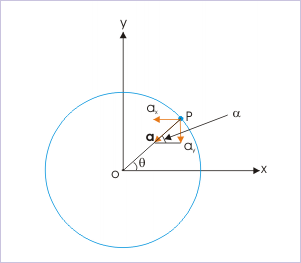| << Chapter < Page | Chapter >> Page > |
This example points to an interesting aspect of circular motion. The centripetal acceleration of the cyclist is actually two (2) times that of acceleration due to gravity (g = 10 ). This fact is used to create large acceleration in small space with appropriate values of “v” and “r” as per the requirement in hand. The large acceleration so produced finds application in particle physics and for equipments designed to segregate material on the basis of difference in density. This is also used to simulate large acceleration in a centrifuge for astronauts, who experience large acceleration at the time of take off or during entry on the return.
Generation of high magnitude of acceleration during uniform circular motion also points to a potential danger to pilots, while maneuvering circular trajectory at high speed. Since a pilot is inclined with the head leaning towards the center of motion, the blood circulation in the brain is low. If his body part, including brain, is subjected to high acceleration (multiple of acceleration due to gravity), then it is likely that the pilot experiences dizziness or sometimes even looses consciousness.
Circular motion has many interesting applications in real world and provides explanations for many natural events. In this module, however, we restrict ourselves till we study the dynamics of the circular motion also in subsequent modules.
Here, we set out to evaluate the angle “α” as shown in the figure. Clearly, if this angle “α” is equal to “θ”, then we can conclude that acceleration is directed in radial direction.
Uniform circular motion

Now,
This proves that centripetal acceleration is indeed radial (i.e acting along radial direction).
A particle under UCM covers a constant distance in completing circular trajectory in one revolution, which is equal to the perimeter of the circle.
Further the particle covers the perimeter with constant speed. It means that the particle travels the circular trajectory in a constant time given by its time period as :
An astronaut, executing uniform circular motion in a centrifuge of radius 10 m, is subjected to a radial acceleration of 4g. The time period of the centrifuge (in seconds) is :
(a) π (b) 2π (c) 3π (d) 4π
From the inputs given in the question,
The time period of the motion is :
Hence, option (a) is correct.
Both these motions are two dimensional motions. They are alike in the sense that motion in each case is subjected to continuous change of the direction of motion. At the same time, they are different in other details. The most important difference is that projectile motion has a constant acceleration, whereas uniform circular motion has a constant magnitude of acceleration.
Significantly, a projectile motion completely resembles uniform circular motion at one particular instant. The projectile has only horizontal component of velocity, when it is at the maximum height. At that instant, the force of gravity, which is always directed downward, is perpendicular to the direction of velocity. Thus, projectile at that moment executes an uniform circular motion.

Notification Switch
Would you like to follow the 'Physics for k-12' conversation and receive update notifications?